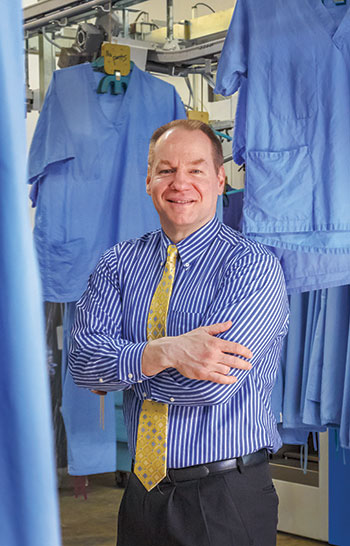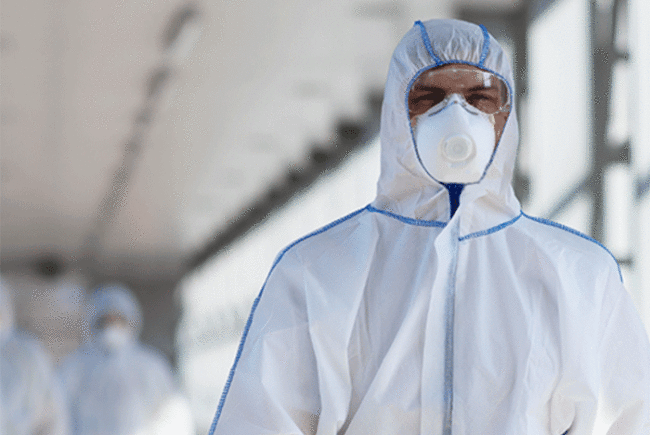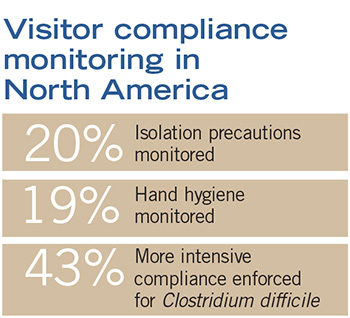 |
| PHOTO BY DOUG WALKER |
Gregory Gicewicz, board president of the Healthcare Laundry Accreditation Council (HLAC), looks at what has been learned since a report published in May 2014 in The Pediatric Infectious Disease Journal identified hospital linens traced to an off-site launderer as the agent of transmission for a deadly fungus that resulted in five deaths at a pediatric hospital.
What chain of events led to the tragic deaths in New Orleans?
Five children died at Children’s Hospital of New Orleans in 2008 and 2009 after coming in contact with a deadly fungus that was transmitted through their linens. The linens had been laundered at an off-site facility, but became contaminated with the Rhizopus delemar fungus at various points in the process after they were washed. This happened because the linens were not adequately protected during handling and transport from the time they were removed from the wash until the time they came into contact with patients. When the Rhizopus-contaminated linen came into contact with the immunocompromised children, they developed zygomycosis [mucormycosis] infections that ultimately contributed to their deaths.
What has been learned from these events?
We’ve learned that rigorous health care laundry standards are critical to patient safety. Furthermore, it’s essential to manage and follow these standards during all phases of the health care laundry process — it’s not enough to focus solely on washing. Clean linen that becomes contaminated after washing is just as deadly as dirty linen that has not been washed. Said another way: Washed, clean linen can become contaminated in the laundry plant, during transport, on hospital loading docks, in hospital linen rooms, in hospital linen closets and even in patient rooms.
The bottom line in this scenario is that hospital decision-makers should be scrutinizing their laundry providers and processes. A step in that direction is to insist that their laundry provider is accredited by an organization whose purpose is to ensure that these standards are being followed every step of the way.
How do health care textiles fit into the larger issue of health care-associated infections (HAIs)?
While documented cases of health care textiles contributing to HAIs and patient deaths are rare, the Children’s Hospital of New Orleans tragedy clearly illustrated how this can happen. And reports of microorganisms on health care textiles as a possible source of patient infections are fairly common. Given that various multidrug-resistant microorganisms can survive on textile surfaces — including health care textiles — for weeks, it is likely that health care textiles can transmit pathogens throughout a hospital wherever they touch or rub against surfaces, including medical devices susceptible to HAI contraction.
How can hospitals ensure that contaminated textiles do not result in HAIs?
The single biggest step is for the hospital to ensure that its laundry provider follows the most rigorous of health care laundry standards to safeguard that clean health care textiles arriving at the hospital are free of contamination.
Once the health care textiles are at the hospital, they must be further protected from contamination until actual patient use. Potential sources of contamination at the hospital include commingling clean linen with soiled linen at the loading dock; inadequate linen protection from the environment at the loading dock; exposure to contaminated air in the hospital linen room; lack of proper hand hygiene by linen handlers at the hospital; and inadequate linen protection when transporting items from the linen room to the floor linen closets to the patient rooms. Eliminating these risks of contamination and others must be part of an enterprisewide HAI reduction program.
The Gicewicz File |
CV• Board president of the Healthcare Laundry Accreditation Council, whose mission is to accredit laundries that process health care textiles based on standards for patient safety and infection prevention • Owner/operator of Sterile Surgical Systems, Tumwater, Wash., a health care laundry and sterile surgical pack processor serving customers in the Pacific Northwest • Group program manager for Windows Live infrastructure operations for Microsoft in Redmond, Wash.; spent 14 years with the company in several senior roles and has applied the information technology lessons he learned at Microsoft to the laundry industry in such areas as linen management, plant operations, infection prevention and plant financials Education• Graduated from Harvard University with a bachelor of arts degree in chemistry and physics Outside interests• Active in the Seattle ice hockey community as a youth coach and an owner of the Seattle Thunderbirds Hockey Club
|
What due diligence should a health facilities professional take when selecting a textile service?
Selecting the right textile service is an often-overlooked but critical decision for a hospital. There is a tendency to focus solely on the lowest-priced provider, but all it takes is a single patient HAI traced back to linen or several occurrences of contaminated linen at the hospital to quickly outweigh any perceived cost savings. Patient safety and service quality should be the key deciding factors.
Due diligence should include such steps as specifying in any request for proposal that all textile service companies be accredited. Visiting potential textile service companies is a must, as is bringing along relevant hospital representatives from environmental services and infection prevention.
During the vendor visit, focus on the plant, the personnel and the process, and have each accompanying representative dig deeper into his or her area of responsibility. Plan to spend several hours at the plant inspecting physical signs and work practices. One area in which you will want to dig deeper is interviewing the finishing staff. Ask them how they disinfect clean surfaces like tables and carts that clean linen will touch and how often they disinfect these surfaces. Also, make sure they are using an EPA-registered and labeled disinfectant.
Ask finishing staff what happens if a piece of linen falls on the floor. It should be put into a reject bin. Observe the workers to see if they are following this practice.
Observe clean areas of the plant for excessive lint buildup. Areas around ironers, dryers, piece folders and feeders are big lint generators. Ask to see blowdown and cleaning schedules. Visibly dirty finishing areas should be a red flag. They are likely a sign of sloppy hygiene practices in other areas of the plant.
During your visit, also observe conventional washer and dryer operators and pay close attention to cross-contamination opportunities. Operators loading conventional washers should be wearing appropriate personal protective equipment (PPE), including fluid-proof gloves and gowns. After the washer is loaded and locked, it must be disinfected on the outside to protect the linen when it is unloaded. Make sure that operators who unload clean linen from washers or load dryers remove dirty PPE and clean their hands.
Look for any areas in the washroom where clean linen may contact soiled linen. Oftentimes, clean linen will be unloaded from a washer that is close to a staged cart of soiled linen, risking cross-contamination.
Observe the cart cleaning process and inspect clean carts after they have been disinfected, looking for soil, lint or dust.
These visual cues and laundry staff interviews are great sources of information. It’s also helpful to bring along the current edition of HLAC’s “Accreditation Standards for Processing Reusable Textiles for Use in Healthcare Facilities.”
Before making a final vendor selection, carefully check references. Reference sites most similar to your health facility are best. While a site visit and a request for proposal may show a provider in its best light at a point in time, actual customer references may tell a different story about how the provider will perform over the long term.
What can health facilities professionals in charge of hospital textiles do to improve their executives’ knowledge?
Get the issue of textile care on their radar. This is where resources like Health Facilities Management demonstrate their importance. When professionals make smart decisions, they’re more likely to share information with their executives in support of their strategies.
Bob Kehoe is a senior editor with Health Facilities Management.





